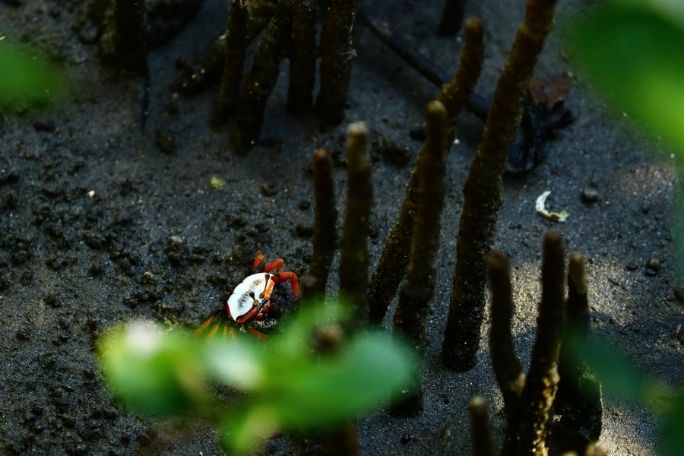Lesson summary
In this flipped classroom lesson, students will research secondary sources to describe measurable causes and effects of changes to the health of mangroves. This research is designed to inspire questions, predictions and hypotheses. Students will brainstorm the events that might cause variations to abiotic factors that influence the health and distribution of mangroves. These considerations may include: climate change, and the increase in the frequency and severity of extreme weather events; alterations to mangrove habitats for other purposes; and the runoff carrying sediments and chemicals. Finally, students will consider a range of questions that could be investigated scientifically that MangroveWatch researchers should be asking.
Learning intentions:
Students will...
- recognise measurable causes and effects of changes to the health of mangroves.
Success criteria:
Students can...
- analyse video reports of threats and pressures upon mangroves
- describe adaptations of mangroves and the implications for adaptation through natural selection as a consequence of climate change
- interpret a conceptual model of a mangrove ecosystem to plan a question for investigation
- explain benefits of MangroveWatch for the environment and community
- develop questions to guide scientific research.
Lesson guides and printables
Lesson details
Curriculum mapping
Australian curriculum content descriptions:
Year 9 Science:
- Ecosystems consist of communities of interdependent organisms and abiotic components of the environment; matter and energy flow through these systems (ACSSU176)
- Formulate questions or hypotheses that can be investigated scientifically (ACSIS164)
Year 10 Science:
- The theory of evolution by natural selection explains the diversity of living things and is supported by a range of scientific evidence (ACSSU185)
- Formulate questions or hypotheses that can be investigated scientifically (ACSIS198)
Year 11 and 12 Science – Biology
- Identify, research and construct questions for investigation; propose hypotheses; and predict possible outcomes (ACSBL001)
- Ecosystems are diverse, composed of varied habitats and can be described in terms of their component species, species interactions and the abiotic factors that make up the environment (ACSBL019)
- In addition to biotic factors, abiotic factors including climate and substrate can be used to describe and classify environments (ACSBL021)
- Human activities (for example, over-exploitation, habitat destruction, monocultures, pollution) can reduce biodiversity and can impact on the magnitude, duration and speed of ecosystem change (ACSBL028)
- Models of ecosystem interactions (for example, food webs, successional models) can be used to predict the impact of change and are based on interpretation of and extrapolation from sample data (for example, data derived from ecosystem surveying techniques); the reliability of the model is determined by the representativeness of the sampling (ACSBL029)
Syllabus outcomes: SC5-14LW
General capabilities: Critical and Creative Thinking, Literacy, Personal and Social Capability
Cross-curriculum priority: Sustainability OI.7, OI.9
Relevant parts of Year 9 Science achievement standards: Students design questions that can be investigated using a range of inquiry skills. They analyse how biological systems function and respond to external changes with reference to interdependencies, energy transfers and flows of matter.
Relevant parts of Year 10 Science achievement standards: Students describe and analyse interactions and cycles within and between Earth’s spheres. They develop questions and hypotheses.
Year 11 and 12 students:
- understand that ecosystem diversity and dynamics can be described and compared with reference to biotic and abiotic components and their interactions.
- understand how theories and models have developed based on evidence from multiple disciplines; and the uses and limitations of biological knowledge in a range of contexts.
Unit of work: MangroveWatch – Years 9 to 12.
Time required: 120 minutes
Level of teacher scaffolding: This lesson should be completed in students’ own time.
Resources required
- Student Worksheets – one copy per student
- Device/s capable of enabling students to work independently
- Devices capable of presenting to the class: YouTube, enlarged ecosystem flow chart and photographs
Skills
This lesson is designed to build students’ competencies in the following skills:
- Communication
- Community engagement
- Creativity
- Critical thinking
Additional info
The lessons in this unit have been developed in partnership with Earthwatch and MangroveWatch. Earthwatch is a global not-for-profit organisation that uses citizen science to empower people to save the natural world, and works with all sectors to create a society that lives in balance with nature. MangroveWatch is a not-for-profit organisation that focuses on the research, education and conservation of mangrove and tidal wetland environments globally.


Welcome back!
Don't have an account yet?
Log in with:
By signing up to Cool.org you consent and agree to Cool's privacy policy to
store, manage and process your personal information. To read more, please see
our privacy policy here(Opens in new tab).
Create your free Cool.org account.
Many of our resources are free, with an option to upgrade to Cool+ for premium content.
Already have an account?
Sign up with:
By signing up to Cool.org you consent and agree to Cool's privacy policy to
store, manage and process your personal information. To read more, please see
our privacy policy here(Opens in new tab).